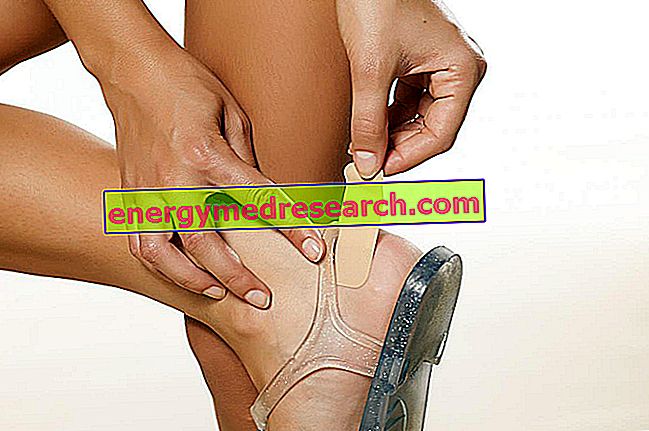Generality
Polymorphous erythema (or erythema multiforme ) is an acute inflammatory disease that mainly affects the mucous membranes and the skin .

The inflammatory process is caused by a reaction of the immune system, which can be triggered by infection or the use of certain drugs . Usually, polymorphous erythema causes mild symptoms and resolves spontaneously within a few weeks.
The polymorphous erythema typically manifests itself with cutaneous "rosette" or "target" lesions, that is constituted by a purple-violet red central disk and a pink halo separated by a pale intermediate ring. At the eruption site, patients may experience itching or a burning sensation.
Erythema multiforme appears mainly on the face and extremities of the limbs (especially the palms and soles of the feet). On some occasions, the inflammation also involves the mucous membranes of the oral cavity, causing erosive lesions and vesicles on the palate and gums.
The diagnosis of polymorphic erythema is based on physical examination; rarely, biopsy is required. Treatment is symptomatic and involves the use, if necessary, of corticosteroids and analgesics. Other measures depend on the etiology: for example, if the pathology is the consequence of an adverse reaction to a drug, it is advisable to immediately stop taking it.
What's this
Polymorphous erythema is an inflammatory disease that involves the skin or mucous membranes. This form of reaction is associated with the use of particular types of drugs or the presence of infectious agents in the body.
Polymorphous erythema usually occurs in an acute form; in some cases, however, it can manifest itself with a recurrent character.
A step backwards: what is an erythema
In dermatology, erythema is defined as any reddening of the skin caused by an increase in blood supply in that particular body area. The peculiarity of this event consists in disappearing under the pressure of the fingers, to then reappear with the cessation of the same. There are various forms of erythema: drug-induced, related to exposure to sunlight or, again, associated with mechanical, thermal, chemical, infectious, toxic, hormonal and psycho-emotional causes. Furthermore, this skin reaction may appear during allergies to drugs, food and personal care products.
Erythema Polymorphous: synonyms and terminology
The polymorphous erythema owes its name to the variegated forms with which the rash that characterizes the clinical picture can be presented. In fact, the eruption can be composed of macules, papules, vesicles, blisters, crusts and "target" lesions, with symmetric and centripetal distribution.
Polymorphic erythema is also called:
- Erythema multiforme ;
- Multiform exudative erythema .
Erythema Polymorphous: types
Polymorphous erythema can manifest itself in various forms, which differ essentially in the location and severity of symptoms .
The main types of polymorphic erythema are:
- Polymorphic major erythema ;
- Polymorphic minor erythema ;
- Toxic epidermal necrolysis (plaque erythema multiforme or Lyell's syndrome).
In polymorphic minor erythema, the symptoms are mild and the lesions are confined only to the skin surface, without mucosal involvement or with limited involvement of the oral cavity alone. Polymorphic major erythema, on the other hand, involves the involvement of the skin and mucous membranes, as well as systemic symptoms such as asthenia, fever and joint pain.
Polymorphic minor erythema is a pathological entity in its own right, while the major form and toxic epidermal necrolysis seem to share the same pathogenetic mechanism. The latter therefore represent simple variations in terms of the severity of the clinical picture.
Causes and Risk Factors
Polymorphous erythema is a muco-cutaneous pathology caused by a cell-mediated immune reaction that causes inflammation .
In most cases, this abnormal response is induced by some infectious agents or is related to the use of drugs (especially penicillins, sulfonamides and barbiturates). Less often, the pathology was found after the administration of diphtheria, tetanus, smallpox, hepatitis B, poliomyelitis and tuberculosis vaccines .
The most frequently identified cause is herpes simplex virus infection . Erythema multiforme can also occur in patients with systemic lupus erythematosus and infection with Mycoplasma pneumoniae .
Polymorphic Erythema: pathogenetic mechanism
Polymorphic erythema originates from an inflammation of the blood vessels supported by a cell-mediated immune reaction that results in tissue damage .
The responsible mechanism is different in the forms induced by infectious agents compared to those related to the use of drugs. In the case of a herpetic infection, for example, the polymorphous erythema results from the immune reaction mediated by T lymphocytes triggered by the nucleic acid of the virus (ie from its DNA); lymphocyte activation stimulates the production of interferon gamma and recruits other cells of the immune system (cytokines, chemokines, cytotoxic T cells, NK cells etc.) which will then determine epithelial damage in the affected area.
In the drug-induced polymorphic erythema, the reaction appears to be triggered by some metabolites of the drug, which determine the production of an inflammatory mediator, tumor necrosis factor alfa ( TNF-α ), capable of causing tissue damage and lesions in both direct (through induction of apoptosis in keratinocytes), and indirect (by recruiting other cells of the immune system).
In polymorphic plaque erythema, on the other hand, there is a widespread necrosis (death of the tissue), which leads to the detachment of the skin .
What causes Erythema Polymorphous?
Infections
- Herpes Virus Simplex (HSV-1 and HSV-2);
- Mycoplasma (the most known infection associated with polymorphic erythema is given by Mycoplasma pneumoniae );
- Varicella-zoster virus (VZV);
- Cytomegalovirus;
- Liver viruses (B and C);
- HIV;
- Coxsachie virus;
- Parvovirus B19;
- Adenovirus;
- Streptococci.
drugs
The drugs most frequently responsible for polymorphic erythema are:
- sulfa drugs;
- Phenytoin;
- Valproic acid;
- penicillins;
- Carbamazepine;
- quinolone;
- Barbiturates;
- Phenobarbital;
- Diclofenac;
- allopurinol;
- Cephalosporins;
- Barbiturates;
- Some vaccines.
Other predisposing or aggravating conditions and conditions
- Malignant tumors: leukemia, non-Hodgkin's lymphoma, multiple myeloma, some neuroendocrine tumors etc .;
- Polycythemia;
- collagen;
- Vasculitis;
- Physical factors: radiotherapy, cold and ultraviolet radiation.
Erythema Polymorphous: is it contagious?
The polymorphous erythema is not in itself contagious, but when it is associated with any infection, it can be transmitted from individual to individual, according to the methods of contagion typical of the causal pathogen.
Risk factors
Polymorphous erythema can affect children and adults, with a slight predominance for males. The age group most affected is that ranging from 20 to 40 years.
Polymorphous erythema tends to occur with prevalence in autumn and spring.
Symptoms and Complications
The symptomatology of polymorphic erythema is variable and correlated to the entity of the clinical picture. The characteristic common to the various forms and typical of the pathology are the cutaneous lesions "with rosette" or "on target" which appear suddenly, like spots with a diameter of 1-3 cm, which widen in concentric circles with a central red disk or purpura, a lighter edematous intermediate ring and an outermost erythematous ring.
The lesions of the erythema multiforme are distributed equally on both sides of the body, so they appear symmetrically on the ends of the arms and legs and on the face. The red patches of polymorphic erythema can be asymptomatic, but sometimes patients may feel a strong burning and itching sensation .

Skin lesions
The polymorphous erythema involves an eruption composed of reddish patches, macules and papules . Sometimes, these signs are surmounted by small blisters or bubbles .
As anticipated, the "target", "iris" or "rosette" skin lesions have a typical polycyclic or annular appearance, with a erythematous-purple central disk and a reddish-pink halo separated by a pale intermediate ring. In concentric spots, moreover, edematous and raised areas are alternated with respect to the surface of the skin to those just depressed.
In polymorphic erythema, inflammation can attenuate or disappear and then reactivate, giving rise to further morphological changes: for this reason, the lesions have a polycyclic or annular appearance .
Erythema Polymorphos: which sites are affected?
Erythema multiforme appears mainly on the face and limbs (back and palms, extensor surfaces of the extremities and soles of the feet). At the eruption site, patients may experience itching or a burning sensation.
Occasionally, erythema multiforme also affects the mucous membranes of the oral cavity, leading to erosive lesions, vesicles, pain and burning on the lips, palate and gum. Sometimes, the pathology also involves the nose and ocular conjunctiva ; the location on the trunk is rarer.
Possible associated disorders
Skin lesions may be the only manifestation of the disease ( polymorphic minor erythema ). Other times, these signs are accompanied by erosive mucosal lesions, involving the oral cavity, nasal mucosa, conjunctiva and genitals ( polymorphic major erythema ).
In larger forms, systemic symptoms occur, such as general malaise, fever, asthenia, joint pain and vasculitis (ie inflammation of the vessels due to recruitment of white blood cells in the context of inflammation).
Polymorphic major erythema can also lead to small bleeding at mucosal level and ocular symptoms such as burning, itching, pain and dryness.
Duration of erythema and timing of appearance
- Polymorphous erythema is a disease that is self-limited, ie it tends to resolve spontaneously within 3-5 weeks . This aspect makes it possible to differentiate the eruption from hives, which lasts a few hours or, at most, only one day.
- Polymorphous erythema usually manifests itself in an acute form ; in a small percentage of cases, however, it can recur and recur repeatedly over time.
- When the erythema multiforme is related to a herpes virus infection, the eruption occurs 7-10 days after the manifestation of the herpetic vesicle. If the reaction is induced by a drug, however, the reaction can start from a few hours up to 7-14 days after its use.
Diagnosis
The assessment of polymorphic erythema is clinical and is based mainly on objective examination . In fact, there are no specific diagnostic tests for the disease and, only in some cases, biopsy is used.
To identify the cause of the polymorphic erythema, if necessary, the doctor can take advantage of some support tests, including:
- Complete blood count;
- Measurement of urea in the blood;
- Dosage of electrolytes;
- VES;
- Liver function test;
- Microbiological cultures from blood, saliva and samples taken from lesions;
- Serological tests for HSV, Mycoplasma pneumoniae or other microorganisms suspected to be involved in the pathology.
Erythema Polymorphous: what should be distinguished?
Erythema multiforme may present characteristics similar to other dermatological diseases:
- In the early stages of polymorphic erythema, the eruption may mimic that of urticaria ;
- Circular lesions, with a cyanotic center (in shades of blue due to lack of oxygen at that cutaneous level) similar to those of erythema multiforme can be found in vasculitis and in systemic lupus erythematosus .
The differential diagnosis must also be placed against:
- Bullous pemphigoid;
- Pemphigus;
- Dermatitis herpetiformis.
Treatment and Remedies

Being self-limiting, polymorphic erythema does not require any specific treatment. The therapy prescribed by the dermatologist mostly serves to control symptoms and depends essentially on the cause.
In particular:
- In cases attributable to adverse drug reactions, immediate suspension of the medicinal product is required.
- If the cause is a mycoplasma infection, therapy involves the administration of tetracyclines.
- In patients with frequent or symptomatic recurrences of herpes simplex, on the other hand, the use of antiviral therapy may be useful.
Warning! Some forms of erythema multiforme, such as the major variant or toxic epidermal necrolysis, require hospitalization in intensive care to avoid life-threatening complications.
Symptomatic therapy
Some medications can help control inflammation and alleviate symptoms of polymorphic erythema, such as itching, fever, fatigue and joint pain. If they are not the cause causing the disease, the doctor may indicate - depending on the specific case - the use of antihistamines, analgesics and corticosteroids by systemic or local application.
The use of mouthwashes containing a topical anesthetic, such as lidocaine, or an antiseptic may reduce the pain associated with oral mucosal injuries and prevent any secondary infection. Ocular involvement should be managed instead by scrupulously following the ophthalmologist's instructions.



